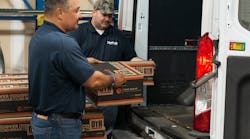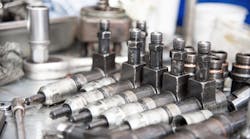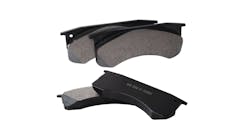There are three general categories of replacement parts: genuine OE, aftermarket, and remanufactured. Achieving two of a fleet’s most critical goals – vehicle uptime and expense control – requires an understanding of all three categories, along with what makes one a better option in certain circumstances.
Tim Bauer, vice president of Eaton’s North America aftermarket vehicle group, likes to separate replacement parts into a good-better-best scenario based on features, benefits, performance, and price. This helps fleets maximize return on investment (ROI) by matching the right type of part at the right stage in a vehicle’s lifecycle. Eaton’s aftermarket offering includes clutch and transmission products to support the Eaton Fuller product portfolio.
Meritor, a supplier of axle, brake, and suspension solutions, formally structures its aftermarket products portfolio the same way:
- Best – Meritor Genuine, ideal for newer trucks and fleets looking to maintain overall condition and genuine performance
- Better – Meritor and Euclid-branded all-makes aftermarket components, ideal for second and third truck owners
- Better – Meritor remanufactured products
- Good – Mach-branded all-makes components focused on value, ideal for trucks in later lifecycle stages
Eaton’s Bauer says that while original equipment (also known as genuine) parts make a lot of sense for newer vehicles, they can also be a good choice for older vehicles. “Many manufacturers have products that are an older design or have been de-featured to provide a balance between performance and price,” Bauer points out.
Sometimes a fleet simply wants to stick with genuine parts. There are several common reasons why.
“One is total cost of ownership, including what the vehicle is worth at trade-in,” says Mike Eppes, managing vice president of parts for Rush Enterprises, which operates roughly 130 commercial vehicle dealerships (Rush Truck Centers) across the U.S. “Overall risk can also be a factor. Some fleets don’t want to take on the liability of using an aftermarket part in case something ever went wrong and they ended up in court.”
Fleets should recognize that genuine replacement parts are components of a system specifically designed and engineered to work together, maintaining the same level of quality originally offered as first fit parts.
“Design tolerances and mechanical properties separate an original part from a will-fit,” says Michael Keller, D.M. director of sales (aftermarket, regional fleet, and dealer) for SAF-Holland. “Altering a system with a will-fit replacement part may result in jeopardizing performance and safety.” The SAF-Holland product offering includes air disc and drum brake axles, spring and air ride suspensions, fifth wheels, landing gear, tire pressure management systems, and coupling products, along with a full line of genuine and premium aftermarket parts to support all of those products.
When considering replacement part options, Eric Coffman, senior product manager at Meritor, says it’s important to recognize that “same as” is not always “equal to.” For example, “Meritor Genuine RSD friction (brake pads) are carefully engineered and selected for their application,” Coffman points out. “Meritor RSD frictions deliver performance that is capable of exceeding the 250-foot regulation by 25 feet, representing nearly two car lengths.”
On the other hand, if a fleet is exploring the value of all-makes parts options, Coffman says the offerings of proven industry leaders can provide some peace of mind. The aftermarket all-makes offerings of OE component suppliers provides opportunity from shared engineering, testing, facilities, and technical support. For example, “Meritor’s PlatinumShield III offers premium protection against rust-jacking, and is available in both OE and aftermarket (parts),” Coffman says.
The case for aftermarket parts
SAF-Holland’s Keller agrees that premium aftermarket parts should only be considered if designed and produced by a trusted manufacturer that understands the importance of safety and uptime.
“The decision to use premium aftermarket parts should be based on more variables than just price, although price plays an important role,” Keller says. “Our Gold Line Quality Parts, for example, are designed and manufactured to the quality standards expected for extended performance.”
Parts vendors can help fleets make wise purchasing decisions. “Our job is to provide as much choice as possible for any make of truck, including OE, a national branded part or a high-quality aftermarket part,” says Larry Gruendike, director of category management for Rush Enterprises.
In addition to Rush Truck Centers, Rush Enterprises also operates Rig Tough Parts, a premium line of aftermarket parts for all makes and models of heavy duty trucks. Robb Nixon, vice president of aftermarket sales for Rush Enterprises, says Rig Tough Parts are backed by a warranty that is as good or better than other parts sold by Rush Enterprises.
While some fleets will only go back to genuine parts, others have a different philosophy that more strongly emphasizes operating cost. Parts-related decisions often hinge on vehicle age, as well as the type of component.
“A cosmetic part is typically less of a concern to a fleet,” Rush Enterprises’ Eppes says. “If a high-quality aftermarket part is available, they’ll often use it over OE. On the other hand is something like an internal engine or transmission part. Should that part fail, the cost of downtime far outweighs the cost savings of going with an aftermarket part.”
Abe Aon, regional aftermarket sales leader for Wabco North America, says his team likes to approach fleets with an ownership lifecycle support perspective. Wabco is a manufacturer of braking systems, steering systems, air compressors, air dryers, and more. The company offers the complete trifecta of replacement parts: genuine OE, remanufactured, and all-makes aftermarket. The company’s all-makes parts offering is available through its ProVia brand, launched in 2016. ProVia parts are designed to bridge the gap between genuine and low-end budget parts.
“A fleet with an older vehicle might not need a part that will last another 15 years,” Aon says. “The fleet might be looking for something that’s a little bit lower-cost and not necessarily to that original OEM spec. At the end of the day, the fleet is going to dictate that to us. Then we give them the best options that will provide the best value for their dollar.”
The case for remanufactured parts
Sometimes a remanufactured part provides the best value.
In addition to Rig Tough aftermarket parts, Rush Enterprises operates its own line of remanufactured parts called Premium Power. Eppes says the company is primarily focused on engine components at this time since the engine is one area where reman can make good financial sense for a fleet.
“Products that include a large amount of cost and energy, such as products with large cast pieces, are good for remanufacturing,” Wabco’s Aon says. Along with engines, examples include air compressors, air dryers, steering gears, and transmissions. “These things make a lot of sense because there is still a lot of life left on the high-dollar components that go into them,” Aon adds.
Founded in 2010, Wabco Reman Solutions remanufactures a variety of electronics, mechatronic components, and conventional mechanical products for both Wabco and other OEMs. Wabco remanufactures back to the original OEM spec. In fact, they’ll also upgrade to the latest features within that product line. “Wabco OEM and Wabco Remanufactured are functionally and durably equivalent,” Aon says. “This gives us an opportunity to bring a better value to market while still maintaining the consistency and specification fleets require.”
While remanufactured parts present a lower-cost option, Eaton’s Bauer says fleets shouldn’t view that as a reflection of inferior product quality. “Remanufactured products can be as good or better than new parts if the remanufacturer has good techniques to qualify reclaimed [salvaged] parts in the operation,” Bauer says.
The manufacturing process itself is also important. John Chalifoux, president and chief operating officer of MERA, the Motor & Equipment Manufacturers Association's sustainable manufacturing division, says it’s important to recognize that remanufacturing has the word manufacturing in it. “If you ever toured the plants of many of our members by starting at the end of the assembly line, you’d think you were in a new manufacturing facility,” Chalifoux relates.
One such MERA member is Reviva, a remanufacturer of diesel engines and components. “If a truck is new enough, there is still the potential of replacing an engine with a new engine,” says Josh Stahl, president of Reviva. “But in many instances, an engine lasts a very long time. By the time it needs to be replaced, it is either no longer produced by the manufacturer or has been greatly modified. In those instances, replacing with a brand new engine isn’t a feasible option for a fleet.”
So what are the options?
- Perform an in-frame overhaul of the existing engine
- Replace with a used engine
- Replace with a remanufactured engine
“The problem with a used engine is that you never know what you’re going to get,” Stahl says. “And with today’s electronically controlled engines, you need to find one that is almost an exact fit.”
An in-frame overhaul can be a good option, but according to Stahl, many fleets do not have either the technician or bay availability to tackle intensive projects like this. “Fleets are often better off flopping a complete engine in a day or two,” Stahl says.
This is where reman fits in. Stahl says Reviva does sell some long blocks, but most of the company’s sales are complete drop-ins. According to Stahl, fleets can have confidence in what they are getting.
“Remanufactured means the engine is completely disassembled in a factory setting,” Stahl explains. “We thoroughly clean and inspect the engine to make sure all parts are qualified. Anything out of spec is discarded. We always use 100-percent new pistons, rings, bearings, and gaskets. All parts must be OE or equivalent. In many cases, it is an OE part. In others, we use reputable names. For example, we might use a Federal Mogul piston that maybe wasn’t specifically made for a certain application but is a proven part and a good fit. We then put the engine on a dynamometer and test it.”
In 2017, MERA launched the Manufactured Again Certification. Manufacturing and remanufacturing are held to the same international quality standards based on ISO 9001 and IATF 16949. Through this effort, a manufacturing process is certified, as opposed to specific products. That said, fleets purchasing remanufactured parts from a certified manufacturer can have an extra degree of confidence in the finished product.
The finer details of parts selection
A fleet should develop its own set of criteria for evaluating replacement parts. According to Eaton’s Bauer, that criteria will likely include:
- Vehicle’s lifecycle stage
- The component itself
- Cost of potential downtime
According to SAF-Holland’s Keller, other factors can also come into play:
- Product warranty
- Strength of company’s presence in the industry
- Manufacturing capabilities
- Distribution footprint
- Knowledge and support provided by vendor’s sales team
- Customer service
Preventive maintenance is another consideration. As an example, Bauer compares Eaton’s Advantage self-adjusting clutch, which is to OE specification, to Eaton’s EverTough genuine aftermarket part:
- Advantage – meets and exceeds OE specifications, recommended lubrication interval of 50,000 miles
- EverTough – high-value option at a lower price point, recommended lubrication interval of 25,000 miles
A fleet should evaluate price point, maintenance needs, and uptime in unison to make the right decision as to which type of part makes the most sense.
It’s also important for a fleet to know who is actually manufacturing the part. According to Bauer, there are some key things to understanding:
- How are the parts approved for sale and use?
- Does the supplier support an ISO/TS process when developing, releasing, and manufacturing products?
- Does the supplier have an OEM position or not?
- What support network is in place to address questions or product issues?
“There is an expectation that all parts sold in the market are proven, tested, and approved with a standard criteria – however, that is not the case,” Bauer says. “When fleets are making a purchasing decision, they should do their research and ask their parts suppliers for products by brand or manufacturer name to ensure they are getting the quality they expect, as well as what they are expecting in terms of performance and support.”
Good parts suppliers provide a good selection, insightful advice, and a shopping experience that makes it as easy and fast as possible to find the right part.
“When you walk into a FleetPride branch, you’ll see shelves stocked with the best-known brands in the industry, plus an assortment of our private brands like OTR,” says Mike Harris, senior vice president of sales and branch operations for FleetPride, a provider of services and parts for heavy duty trucks and trailers with more than 270 locations across the country. “We’re focused on having what the customer needs for their particular application with the quality attributes, warranty, and price points that make the most sense for the job at hand.”
Parts availability is also a key consideration when it comes to selecting parts.
Rush Enterprises has made significant investments to simplify and expedite parts shopping for fleets. RushCare Parts Connect, launched earlier this year, is an online ordering system that allows fleets to shop parts for all makes and models of medium and heavy duty trucks.
“Parts Connect gives the fleet e-commerce capability, as well as the ability to view all of our parts inventory across the country,” Nixon says. Parts Connect is also set up to provide not only the OE part number but also up to three alternative aftermarket part numbers. Pricing is also displayed to help the fleet make a faster, more informed decision.
Faster, yet more informed replacement part decisions should be the goal of any fleet. By understanding the types of parts available, along with when and where each type makes the most economic sense, fleets will be well on their way toward achieving that goal.






